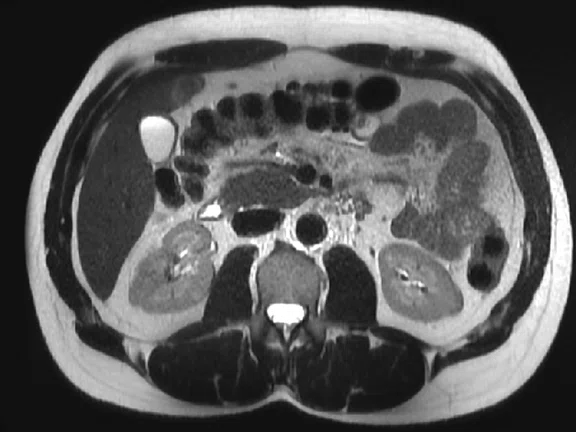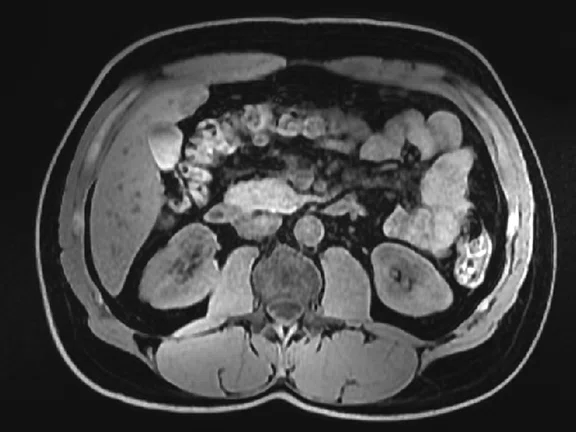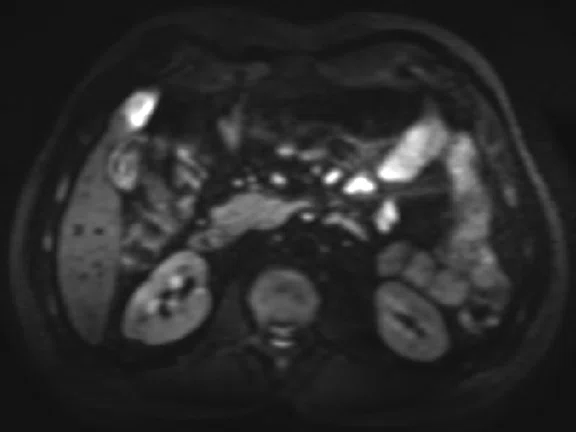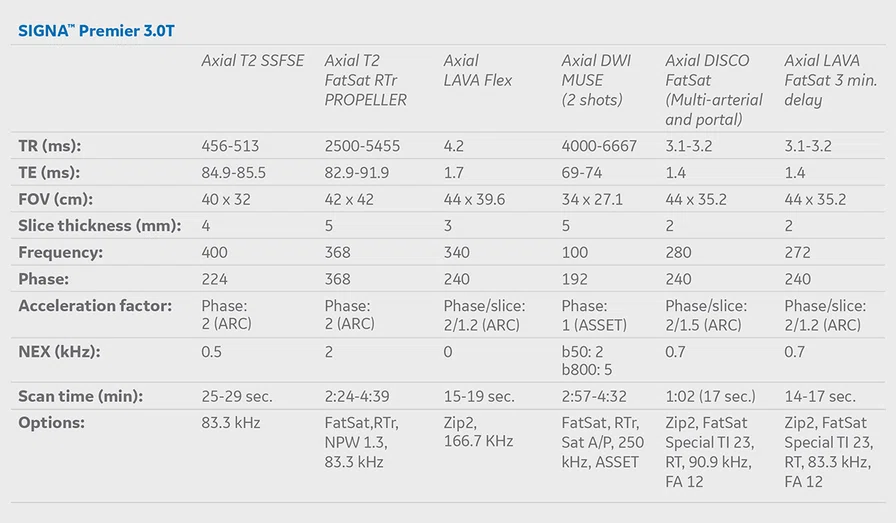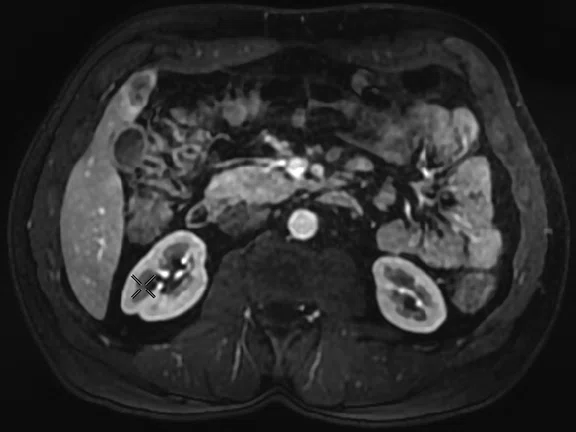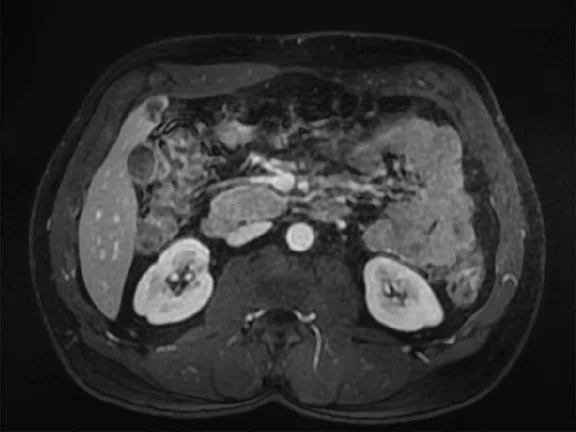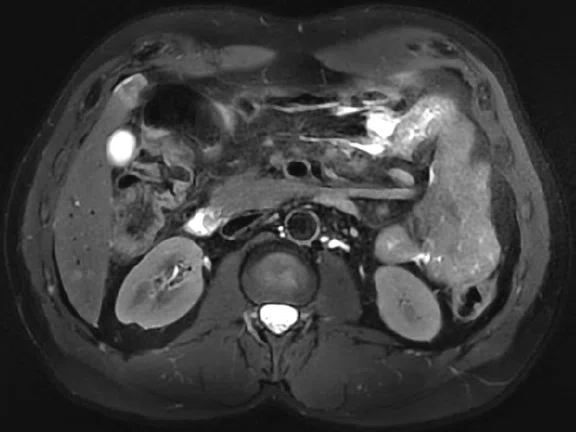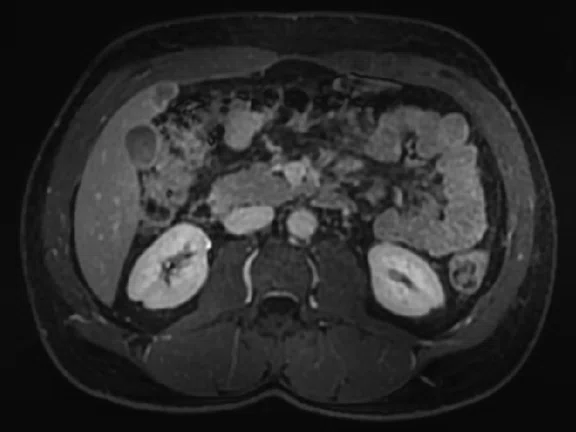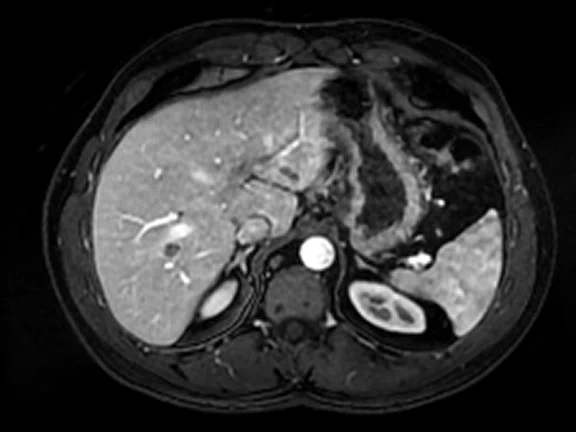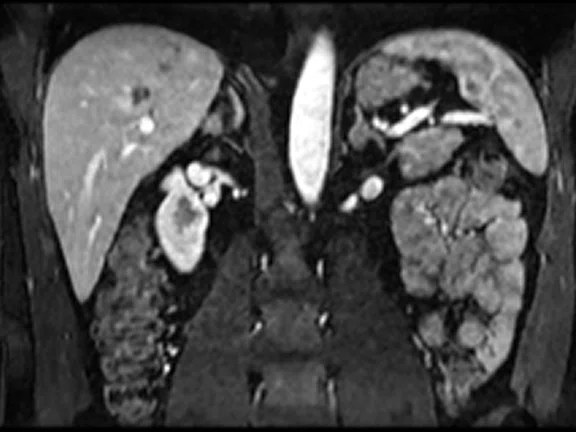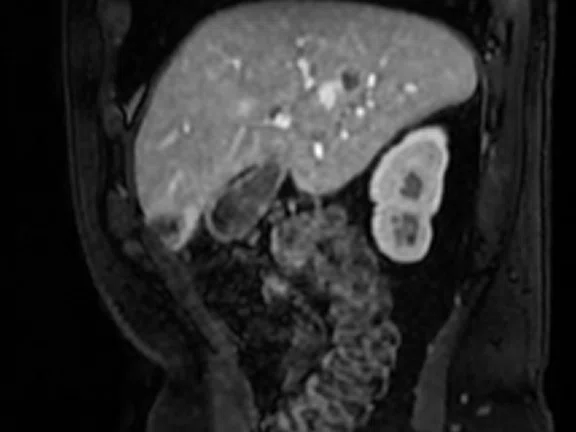‡Not yet CE marked for 1.5T. Not available for sale in all regions.
1. Villanueva-Meyer J, Shin D, Li Y, et al. Denoising MR Images of the Cervical Spine: Multi-Reader Assessment of a Deep Learning Approach. Radiological Society of North America 2019 Scientific Assembly and Annual Meeting, December 1 - December 6, 2019, Chicago IL. archive.rsna.org/2019/19018947.html. Accessed October 7, 2020.
1. Baranas L, Luciani A. Imagerie des tumeurs bénignes du foie: actualisation 2014. Association Française de Formation Médicale Continue en Hépato-Gastro-Entérologie. Available at: https://www.fmcgastro.org/wp-content/uploads/file/pdf-2014/29_Luciani_1_630_v1.pdf.
A
Figure 1.
A 52-year-old male with metastatic colon cancer situated in right colic angle (hepatic angle). (A) Conventional SSFSE T2 sequence with a slice thickness of 3 mm and breath-hold was acquired in 25 sec. (possibility of two breath-holds). (B) LAVA Flex with breath-hold acquired in 19 sec. for in and out of phase, (C) MUSE multi-shots HR with respiratory trigger provide us with a good characterization of the lesion without compromise on image quality. These sequences were acquired before injection of gadolinium.
B
Figure 1.
A 52-year-old male with metastatic colon cancer situated in right colic angle (hepatic angle). (A) Conventional SSFSE T2 sequence with a slice thickness of 3 mm and breath-hold was acquired in 25 sec. (possibility of two breath-holds). (B) LAVA Flex with breath-hold acquired in 19 sec. for in and out of phase, (C) MUSE multi-shots HR with respiratory trigger provide us with a good characterization of the lesion without compromise on image quality. These sequences were acquired before injection of gadolinium.
C
Figure 1.
A 52-year-old male with metastatic colon cancer situated in right colic angle (hepatic angle). (A) Conventional SSFSE T2 sequence with a slice thickness of 3 mm and breath-hold was acquired in 25 sec. (possibility of two breath-holds). (B) LAVA Flex with breath-hold acquired in 19 sec. for in and out of phase, (C) MUSE multi-shots HR with respiratory trigger provide us with a good characterization of the lesion without compromise on image quality. These sequences were acquired before injection of gadolinium.
A
Figure 2.
Dynamic 3D DISCO SPECIAL sequences with gadolinium are acquired for lesion characterization. This sequence has a temporal resolution of 8 sec. (A,B) Double multi-arterial two times followed by (C) a portal time and (D) a late time and 3 min. after injection of contrast.
B
Figure 2.
Dynamic 3D DISCO SPECIAL sequences with gadolinium are acquired for lesion characterization. This sequence has a temporal resolution of 8 sec. (A,B) Double multi-arterial two times followed by (C) a portal time and (D) a late time and 3 min. after injection of contrast.
C
Figure 2.
Dynamic 3D DISCO SPECIAL sequences with gadolinium are acquired for lesion characterization. This sequence has a temporal resolution of 8 sec. (A,B) Double multi-arterial two times followed by (C) a portal time and (D) a late time and 3 min. after injection of contrast.
D
Figure 2.
Dynamic 3D DISCO SPECIAL sequences with gadolinium are acquired for lesion characterization. This sequence has a temporal resolution of 8 sec. (A,B) Double multi-arterial two times followed by (C) a portal time and (D) a late time and 3 min. after injection of contrast.
‡510(k) pending with the US FDA. Not yet CE marked. Not available for sale.
‡510(k) pending with the US FDA. Not yet CE marked. Not available for sale.
‡‡Not yet CE marked for 1.5T. Not available for sale in all regions.
A
Figure 3.
Dynamic 3D DISCO SPECIAL reformatting on 3 planes, with 2 mm of thickness ZIP2 to obtain 1 mm on reformat. This sequence shows us that we can appreciate an excellent quality image without compromise.
B
Figure 3.
Dynamic 3D DISCO SPECIAL reformatting on 3 planes, with 2 mm of thickness ZIP2 to obtain 1 mm on reformat. This sequence shows us that we can appreciate an excellent quality image without compromise.
C
Figure 3.
Dynamic 3D DISCO SPECIAL reformatting on 3 planes, with 2 mm of thickness ZIP2 to obtain 1 mm on reformat. This sequence shows us that we can appreciate an excellent quality image without compromise.
result


PREVIOUS
${prev-page}
NEXT
${next-page}
Subscribe Now
Manage Subscription
FOLLOW US
Contact Us • Cookie Preferences • Privacy Policy • California Privacy PolicyDo Not Sell or Share My Personal Information • Terms & Conditions • Security
© 2024 GE HealthCare. GE is a trademark of General Electric Company. Used under trademark license.
IN PRACTICE
A 10-minute complete abdominal MR exam
A 10-minute complete abdominal MR exam
by Francois Legou, Centre Cardiologique du Nord Hospital, Saint-Denis, France
Abdominal MR plays a major role in the detection and characterization of intra- and extra-hepatic lesions, making it possible in certain cases to postpone percutaneous biopsy, and also in the study of hepatic overload pathologies. It is one of the most complete techniques and a great semiological wealth in abdominal imaging.
Abdominal MR plays a major role in the detection and characterization of intra- and extra-hepatic lesions, making it possible in certain cases to postpone percutaneous biopsy, and also in the study of hepatic overload pathologies. It is one of the most complete techniques and a great semiological wealth in abdominal imaging.
Schematically, an abdominal MR exam is part of either a lesion detection process or a characterization process for a lesion visualized by another imaging method. MR imaging is often recommended as a second-line exam after an ultrasound or a CT scan, allowing a diagnosis to be refined with excellent precision. However, the French Society of Radiology (SFR) states that MR should be the first imaging method used for the characterization of hepatic lesions1.
Depending on the clinical indication specific to each patient, an abdominal MR exam can sometimes be long and therefore uncomfortable for the patient. The challenge lies in the fact that the patient must be as cooperative as possible throughout the exam in order to obtain diagnostic image quality. Shortening exam time would be very important for improving this type of exam.
In September 2019, we installed a SIGNA™ Premier 3.0T system in our hospital along with the 30-channel AIR™ Anterior Array (AA) Coil. Nearly half of our weekly abdominal MR exams (average 30/week) are now performed on this system. The AIR™ AA Coil combined with the power of the SuperG gradient of SIGNA™ Premier allows us to configure abdominal exam protocols by accelerating sequence times, without any real compromise in image quality.
Figure 1.
A 52-year-old male with metastatic colon cancer situated in right colic angle (hepatic angle). (A) Conventional SSFSE T2 sequence with a slice thickness of 3 mm and breath-hold was acquired in 25 sec. (possibility of two breath-holds). (B) LAVA Flex with breath-hold acquired in 19 sec. for in and out of phase, (C) MUSE multi-shots HR with respiratory trigger provide us with a good characterization of the lesion without compromise on image quality. These sequences were acquired before injection of gadolinium.
Technique
Each exam was performed on the SIGNA™ Premier with the AIR™ AA Coil, which can cover up to 60 cm in length. We establish an intravenous line before the start of the exam if the use of contrast is needed after the first sequence. There is no prior administration of anti-peristalsis.
We have been evaluating the use of fast protocols that allow us to reduce exam times to as short as 10 minutes while still obtaining six sequences for a complete exam to facilitate diagnosis. In general, the exam includes a series of breath-hold sequences – SSFSE T2, FSE T2 PROPELLER with FatSat coupled to the respiratory trigger, and LAVA Flex – followed by MUSE using b-values of 50 and 800 mm2/sec with a respiratory trigger before injection. The dynamic sequence DISCO with FatSat allows us to obtain multi-arterial and portal phases while axial LAVA FatSat delivers a 3-minute delay late phase.
Results
Prior to the implementation of our rapid abdominal scan protocol (see parameter table on previous page), each exam would take 20 to 25 minutes. Approximately 10 to 15 percent of these exams failed or resulted in poor diagnostic quality images.
Now, with the 10-minute abdominal scan, we are experiencing fewer failed/poor quality exams. As important, patient compliance improved due to the shorter exam time and the enhanced comfort with the AIR™ AA Coil. Further, the technological advancements of the AIR™ AA Coil – with a high channel count and reduced noise due to the coil elements being closer to the anatomy – allow for a clear increase in image quality. Radiographers report the coil is easier to handle and position on patients due to the coil’s flexibility to conform to different sizes and shapes.
We look forward in the future to utilizing HyperSense, a compressed sensing technique that enables either a shorter late enhanced phase or higher spatial resolution. Two emerging sequences may further advance abdominal imaging: LAVA HyperSense‡ is designed to enable either a shorter late enhanced phase or higher spatial resolution and DISCO Star‡, designed to provide the possibility to acquire dynamic acquisitions as a complete free-breathing radial acquisition. Applying image reconstruction techniques like AIR™ Recon or AIR™ Recon DL‡‡ could further reduce acquisition time on SSFSE sequences and potentially in T2 FatSat and DWI sequences.










